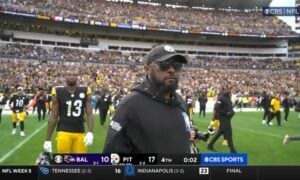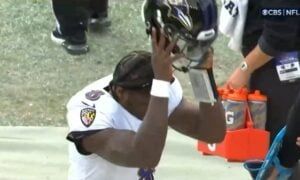By Matthew Marczi
Yesterday, we got a chance to take a look at some of the numbers produced by this year’s reserve offensive lineman candidates for the Pittsburgh Steelers—excepting, of course, the rookies and first year players, from Joe Long to Mike Farrell. With the exception of Guy Whimper, who is a serious question mark for making the team, there is not much experience at all in terms of depth.
That got me wondering how that compared to recent years. Is this the most inexperienced pool of players the Steelers have had in a while? How do they stack up to other reserve crews from the past few seasons?
Last year’s numbers are somewhat hard to quantify when it comes to the guards. David DeCastro, for example, was supposed to be the starter, but was injured in camp, and only came back to start the last three games of the year. The player that he beat out, Ramon Foster, however, started every game, and will start at left guard this year. Add in the fact that center Maurkice Pouncey started a couple games at left guard and you see how it can get confusing.
The only true backups, then, were really Doug Legursky and John Malecki. Malecki saw all of 14 snaps in pass protection, but he did not give up a single hurry. Legursky, on the other hand, gave up four hurries, two hits, and three sacks in just 94 snaps at guard.
As previously mentioned, Malecki really struggled in the run game, however. Legursky had his issues too, but his run blocking was better than his pass protection. Interestingly, his run blocking at center was not as good, but his pass protection was better. In 155 snaps at center in pass protection, he gave up three hits and three hurries.
Kelvin Beachum and Mike Adams, both rookies, made up the reserve tackles on the year, filling in at right tackle. Adams had a number of shining moments in the running game, but some flaws in that area almost balanced out his production. However, he struggled in pass protection, giving up seven sacks, three hits, and another 16 hurries in 279 pass protection snaps.
Beachum, in 195 pass protection snaps, gave up just two sacks, but also allowed three hits and 13 hurries. His run blocking was inconsistent, but he was able to play better against lesser talents.
So what about 2011, then? For one, Marcus Gilbert received a lot of unexpected playing time as a reserve due to the injury to Willie Colon in game one. While he did forfeit eight sacks in 453 pass protection snaps, he allowed only two other hits and 11 more hurries for a respectable overall performance.
In the running game, however, his inconsistencies were a concern as a rookie. He really struggled against the Cleveland Browns and the Kansas City Chiefs. He did battle a shoulder injury, however.
In 2011, Legursky was fairly adequate at both guard positions, both in the run game and in pass protection, but he suffered all around at center. Yet the team tended to play better overall with him at center than at guard, hence the team moving Pouncey to guard for two games last season.
In fact, Trai Essex’s one start at center was better than Legursky’s time there, though still below average. It was also notably better than his stints at guard and tackle in 2011 as well. All told, in about 250 snaps, he gave up two sacks, two hits, and 11 hurries.
Last, but not least, is Jonathan Scott. While technically the starter to begin the 2011 season, his position as such was more predicated upon the health and contract of Max Starks. When healthy, Starks was re-signed, and Scott did not play another snap at left tackle.
He did, however, play 384 snaps at both left and right tackle that year. 203 of those snaps were in pass protection, and he gave up six sacks, two hits, and 12 hurries in that time, mostly at left tackle.
Scott’s 2010 statistics, however, include four sacks on 32 pressures, which made for a somewhat respectable pass blocking efficiency of 93.6. That was actually better than Flozell Adams’ six sacks on 40 pressures for a pass blocking efficiency of 93.3. Scott was often a punching bag for fans, but the truth is that he helped the Steelers reach the Super Bowl that year by stepping in for Starks when he went down.
In fact, it was his run blocking that was the real culprit in 2010. Nobody struggled more in that area on the team that year than he, though Legursky had his difficulties at guard. In 2010, as in 2012, Legursky was again better overall at center than at guard; however, he had hardly an eighth of the amount of snaps at center, so it was a small sample size.
Trai Essex had a really rough go of it in 2010. He had a good game opening week one as the starting right guard, but he performed so poorly over his next four starts (which jump from week 2 to week eight) that he saw little time after that.
However, he must be commended for stepping in during the first playoff game against the Baltimore Ravens. He turned in a workmanlike effort at right tackle, playing over half the game, and helped give the Steelers the chance they needed to come back and win.
Tony Hills even gets a mention in this article. Remember him? He played 43 snaps in 2010. He was forced to play left tackle for 29 snaps, and it did not go well. In just eight snaps in pass protection, he gave up a sack, a hit, and a hurry. His run blocking was no better. In fairness, he somewhat redeemed himself later on in the season with a 14-snap stint on the right side.
2009 was actually a fairly clean season for the offensive line. Starks and Colon played virtually every snap at tackle, while Justin Hartwig took just about every snap at center. Trai Essex missed just four snaps at right guard. Even Chris Kemoeatu missed only four starts, with Foster taking those starts in his rookie year. The first three of those starts were not pretty (he had a really rough game in pass protection against the Ravens despite not giving up a sack), but he did manage to close out the year with a good game against the Miami Dolphins.
So there is your answer, I suppose. The last time the Steelers had a group of reserve linemen this inexperienced was in 2009. They lost Alan Faneca in 2007, Jeff Hartings the year before, and that year lost both Marvel Smith and Kendall Simmons. Meanwhile, Legursky spent 2008 on the practice squad. Kraig Urbik was just drafted, not seeing any playing time, while Foster was an undrafted free agent that year. Tony Hills was in his second season, and saw no action that year or the year prior. The ‘veteran’ of the group was Essex, a third round pick from 2005.
Given the lack of depth, the Steelers will want to stay even healthier along the offensive line than they were in 2009—after all, they missed the playoffs that year. Only one key reserve from a year ago—Beachum—is still a reserve there now, with Adams moving into the starting lineup and Legursky jettisoned from the team.
The Steelers closed 2012 with three linemen on injured reserve and seven total on the 53-man roster, with one having been called up from the practice squad. Two of those seven did not finish the last game. It is conceivable that they start the 2013 with just seven on the roster with no injuries. Who will be the seventh lineman, and is there even one worthy of being the eighth, let alone the ninth? A young crop of undrafted first year players will hope to give some positive answers to those questions starting with training camp in less than a week.







